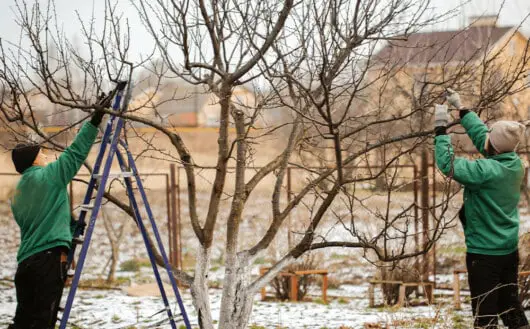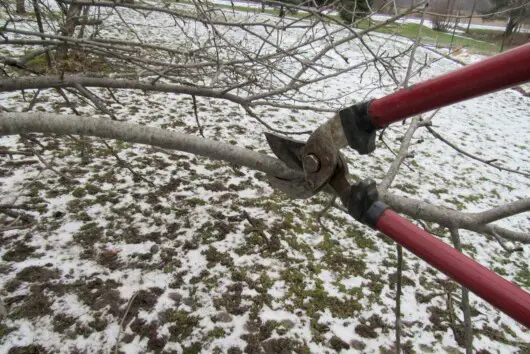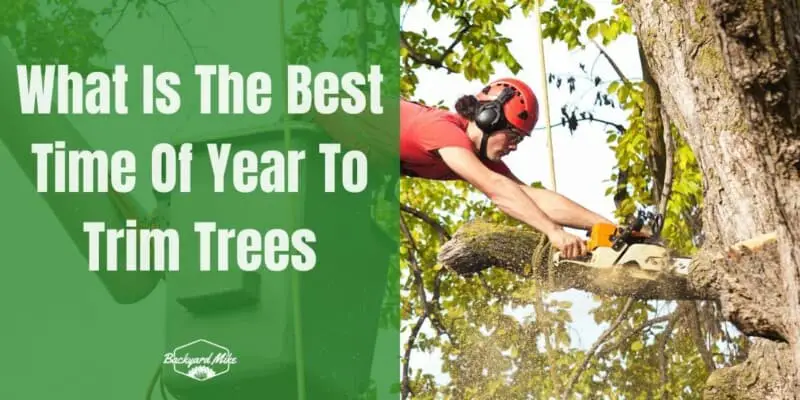Should you prune in winter or summer? What is the best time of year to trim trees? Trimming your trees at the right time is more important than you may think. This article will let you know all about when and how to prune trees and maintain your yard.
When is the best time for trimming trees? No, it’s not Fall
For some weird reason, many people believe that the fall season is the best time for trimming trees, especially in places that get four seasons a year. The bright leaves will start falling, and large limbs will look a little iffy. However, this assumption can easily damage even the most well-maintained gardens and backyards.
The fall isn’t the best time to prune trees, instead, the best time for pruning trees is the winter season. If you just start cutting branches during fall, you are not going to see exceptional results. Unless it is a necessity to prune trees during the fall season, then avoid it. Save the tree cutting and pruning tasks for when the tree is completely dormant in the winter season. In today’s world, qualified tree care specialists can prune trees year-round without any detrimental effects. The specialists understand the different stages and processes like dormancy and new growth.

Most homeowners don’t really know the kind of trees they have on their property until an extreme crisis happens. Learning about the trees and their needs to stay healthy can add value to homes and beautification to your home.
Always prune depending on your tree type
Most routine pruning tasks are done for removing infestation or weak and dead branches. Pruning need to know that growth and wound closure is heightened when pruning is done in the winters. This will help with the spring growth spurt. Wounds from pruning can often spread diseases. Oak trees, for instance, can sometimes suffer from oak wilt. Each cut can potentially change the way the tree grows. This is why you shouldn’t cut the branches without a clear reason.
Homeowners can easily remove dead branches for making the tree look better and stronger. They even prune hazardous branches that can fall on someone or on the house during thunderstorms. Shaping trees can further enhance light diffusion and the airflow in your house.
What time of year should trees be cut down will depend on the type of tree. Here are different types of trees and their best time for trimming.
Deciduous
These types of trees shed their leaves each year. The deciduous trees need to be pruned in late fall to winder. Once they have entered their dormant season, it’ll be easy to see the framework of the branches.
Subtropic
You can trim trees year-round in areas like California and Florida due to their growing environment. They easily replace lost tissue constantly and get ample sunshine and water year-round. However, you cannot prune large limbs every few days or weeks. The standard is to never make cuts that remove more than 30% of live tissue from trees in any season.
Young trees
Developing a strong, good-shaped tree will require proper pruning. Young trees must be trimmed during the winter season. Trees that get the right amount of pruning while they’re young will need less trimming as they grow older. A professional will know the exact time of the year when trimming should be done.
Flowering trees
Flowering trees must be pruned after blooming. Routine pruning of dead/dying branches can be carried out at any time. However, different kinds of trees will have different needs and rules for trimming. Know about the flowering trees and plants you should always prune in winters.
New trees
For new trees, you can inspect for pruning needs all year-round. You should prune trees regularly as it’ll help keep them safe, healthy, and aesthetically pleasing. Avoid waiting until the limbs get too large. Large limbs will equal bigger wounds, which are very difficult for a tree to seal. Further, it leaves the tree open to insects, disease, and rot. Never try to chop off the trees to reduce their size as a substitute for proper tree selection. This practice is called topping and will hurt your trees.
Tips for pruning in the winter season
- Prune on a dry, mild day. Not only will it be pleasant for you, but it’ll also prevent the spreading of waterborne diseases or damage from cold temperatures.
- When pruning, first you should prune the dead and diseased branches, especially the ones caused by snow during winters.
- Never prune during early winters, as incisions could dry out if the temperatures drop below the freezing point.
- Unwanted lower branches on evergreen shrubs and trees need to be removed during later winters.
- Remove smaller or overgrown branches and increase the light and air at the crown of the tree.
- Cut branches at the node of the tree, the point at which the branches and twins attach to one another.
- Your goal should be to keep the branches that develop and maintain the structure of the tree.
What happens if you prune a tree at the wrong time?
The cuts made to healthy limbs and branches can easily make your tree vulnerable. It weakens their defense against pests, disease, and rot while creating openings by which these can get inside. Therefore, you must avoid doing any pruning tasks during the times of the year when the agents are active. Pruning when the tree is developing new flowers will force the tree to consume energy stored for producing replaceable buds. It will put unnecessary stress on the tree. It can also result in smaller and sporadic blooms, as the replacement buds might not mature in time.
Don’t prune a tree when it is still blooming. You must wait until the leaves have developed into a tree that produces a heavy sap flow. Further, you will end up making the tree susceptible to drought and diseases by putting the tree under intense stress. You shouldn’t prune trees during the height of their foliage. A tree’s leaves will absorb energy from the sun that the plant transforms into food through photosynthesis. In case you remove the foliage, the tree will have a hard time getting the nourishment it requires for growth.
Can you fix a botched pruning job?
In all honesty, there is no way to fix a mistake like a botched pruning job. If that happens, all that you can do is wait for the branches to grow and hope for the best. The good news for you is, if you have not over-pruned, you won’t end up with a totally dead tree. Sure, it may not bloom or grow for a while, but it’ll recover after a few years or months. The best thing to do at this point would be to consider it a lesson and never repeat the mistake.
Do tree branches grow back after cutting?
You will need to pay attention to the answer to this question. If you’re wondering do tree branches grow back after cutting, then the unfortunate answer is no. Branches will not grow back after pruning. Instead, new branches grow in place of the older branches that have been pruned. This will depend on a lot of factors.
A significant factor that determines whether a tree grows new branches after pruning includes the part of the tree cut. If you want the tree to grow new branches after pruning, then you should avoid cutting into the tree wood. Instead, you need to cut into the branch wood. If you’re cutting into the trunk wood, the tree branch will take a long time to grow back. In the majority of the cases, they wouldn’t grow back at all. If you cut into the tree trunk, it’ll destroy the tree’s ability to grow new branches either permanently.

You can easily avoid this kind of damage to your tree when pruning your tree. You simply need to cut the branches and trees with caution and ensure that you cut only the branch wood. If you don’t trust your hands enough, you can always call for a professional to handle the pruning tasks.
Another critical factor to keep in mind will be to avoid tree topping. This will make sure that the tree branches will grow back after pruning. Tree topping will be when the branches of the tree are cut from the top down to the trunk. Most tree owners feel that they should carry out tree topping during stormy or rainy weather. They think that it is the best way of keeping branches from falling off. They also make the assumption that the pruned branches grow back exactly where they were. They also feel that they have only temporarily shortened the branches.
This is a wrong assumption. By carrying out tree topping, you’re severely damaging the tree. The branches do not actually grow back. If they do, they will grow back weaker than they were before being pruned. It will leave them much more susceptible to being destroyed during stormy or rainy weather.
Conclusion
When asked what is the best time of year to trim trees, many believe it to be the fall. However, that is wrong. In fact, the winter season is the best time to prune trees. Hopefully, this guide would have given you all the important answers and tips about pruning trees. Further, you must keep in mind that pruning in the wrong season can damage your trees.


